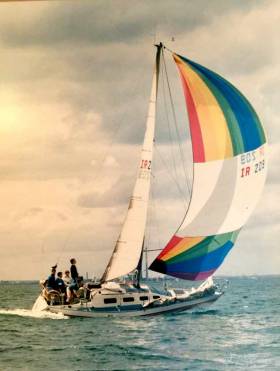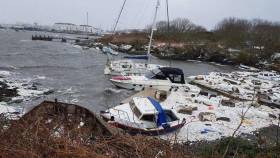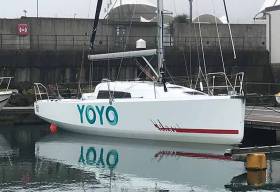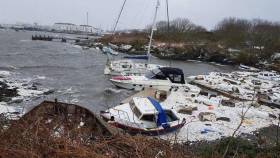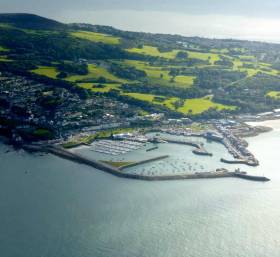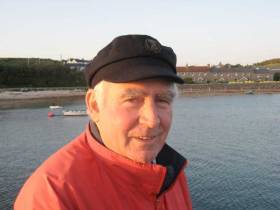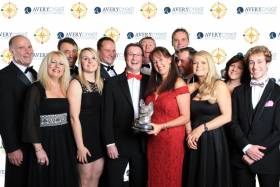Displaying items by tag: ISORA
“Peter Ryan of ISORA”. That’s all you have to say to anyone who knows anything of the Byzantine workings of the sailing scene in and around Ireland, and they’ll immediately know not only know exactly who you mean, but will almost as quickly have a vision of how well things can work when the right people are doing both the heavy lifting, and the clear thinking. W M Nixon shoots the breeze with a man who makes good things happen in sailing, and particularly in local offshore racing.
Peter Ryan’s life in sailing - and how he came into our sport in the first place - is instructive for those who would hope to establish an accessible structure with enticing programmes which get worthwhile newcomers engaged, and keep them engaged.
For he isn’t from a sailing family, and he hasn’t been through any formalized introductory and instruction sailing course. On the contrary, he’s from a classic Dublin family of publicans. The family house is Ryan’s of Beggar’s Bush, in which he still has a share, though we hasten to inform readers unfamiliar with Dublin that despite its name, the Beggar’s Bush neighbourhood is in Dublin 4, one of the city’s most affluent areas.
But as for this boy from Beggar’s Bush, he has spread his wings - professionally he’s now a leading Dublin-based chartered structural engineer, thanks to navigating his educational way through the Jesuits at Belvedere and the rather different yet still quintessentially Dublin atmosphere of Trinity College. And in sport, he has become one of the most quietly yet significantly influential figures in sailing.
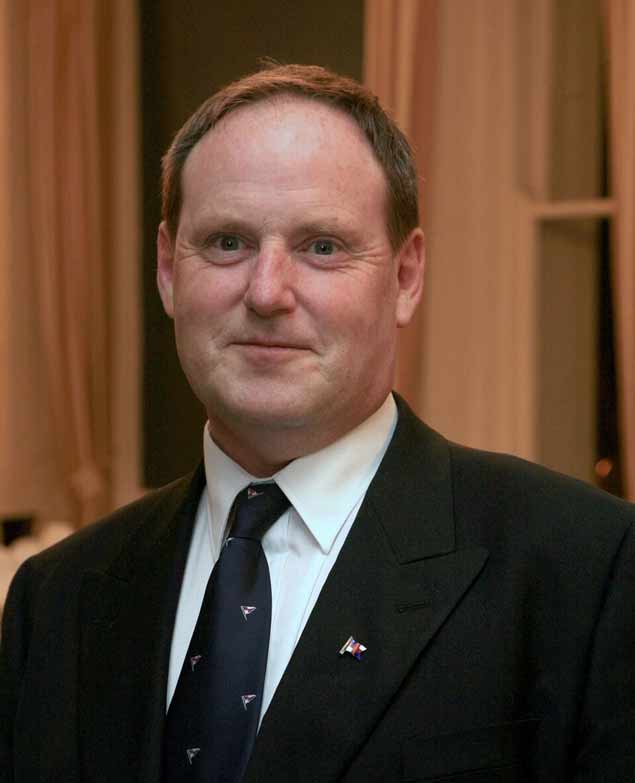 Peter Ryan on his election as Commodore of the National YC in 2008
Peter Ryan on his election as Commodore of the National YC in 2008
As he will be turning 60 in June this year – though he has the energy and continuing enthusiasm of someone twenty years younger – it can be quickly calculated that at the time of his youth, a proper Dublin family pub was a serious business, and fripperies like sailing would be way down the agenda. Yet he was sailing by the age of twelve, thanks to a school friend at Belvedere being Mark Cassidy, whose father Liam raced the 25ft Glen One-Design Glengesh out of the Royal St George YC with the Dun Laoghaire fleet.
However, it was not with regular DBSC racing that his interest was whetted – instead, it was a school vacation-time expedition with the Glens and the Dublin Bay 21s and others to Wicklow Regatta on the August Bank Holiday weekend, a complete experience with a spot of “offshore” sailing which introduced an observant schoolboy to many aspects – some of them good, some of them maybe quite not so good – of the Irish sailing scene.
He had by no means become a devoted sailor – at school he was “a reluctant Third Cs rugby player, but handy enough at cricket playing for Merrion in the summer, and Belvedere in term time”. But when he was courting Anne-Marie Horgan and her father Michael discovered the daughter’s new boyfriend had done a spot of sailing, he almost immediately roped the lad into crewing on his Flying Fifteen sailing out of the National Yacht Club, and Peter Ryan has been involved with the National – and the remarkable Horgan family – ever since.
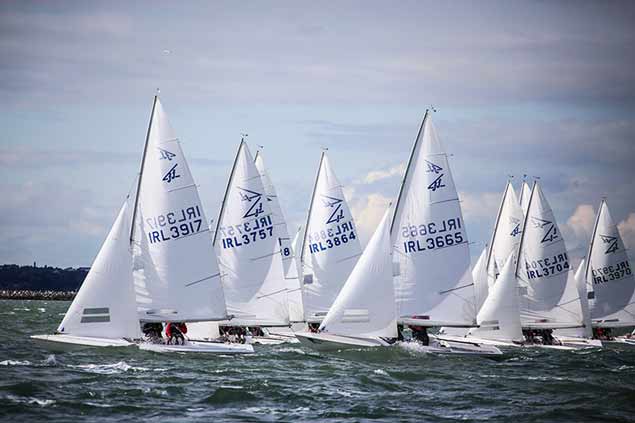 The Flying Fifteens in Dublin Bay provided Peter Ryan with his first real introduction to sailing. The National YC continues to be a stronghold of the class, and will be hosting the F/F Worlds next year.
The Flying Fifteens in Dublin Bay provided Peter Ryan with his first real introduction to sailing. The National YC continues to be a stronghold of the class, and will be hosting the F/F Worlds next year.
It’s timely here to reflect on how the Dun Laoghaire Flying Fifteen fleet has played a leading role in introducing people to sailing. Thanks to its little keel, a Flying Fifteen can provide what is otherwise almost the complete dinghy sailing experience without the inevitable capsize. For people who have never been through the Junior Training Programme, where learning how to handle a capsize is part of the curriculum, the Flying Fifteen is a Godsend, and for Peter Ryan it drew him ever more into sailing, and he went on to crew in the class for Richard Nolan.
On the educational side, he had been interested in studying chemical engineering at third level, but found that while his list of school qualifications best fitted the Trinity College requirements, the range of subjects available at TCD at that time simply didn’t include chemical engineering. However, he re-focused so neatly on the structural engineering course which was available that today it is difficult to imagine him doing anything else at a professional level.
Meanwhile, he was now thoroughly drawn into the life of the National YC, what with being on course to marry Anne-Marie Horgan in 1982 (their two children are now 30 and 21), continuing Flying Fifteens racing, and having his first taste of full-on keelboat racing with DBSC. So he cheerfully admits he began offshore racing when that renowned skipper Liam Shanahan came into the snooker room of the club and spotted a likely crew-member in young Ryan. In his early 20s at the time, he was signed on for an up-coming offshore race in Liam Shanahan’s newly-acquired db2S Lightning, and that was Peter Ryan hooked into the offshore game.
 The Dehler db2s. His first offshore race on Liam Shanahan’s Lightning gave Peter Ryan a livelong love of this side of sailing.
The Dehler db2s. His first offshore race on Liam Shanahan’s Lightning gave Peter Ryan a livelong love of this side of sailing.
The Shanahan and Horgan families were comfortable with each other in the time-honoured National YC way, and as Liam Shanahan found himself in a two-boat situation as he still had his well-campaigned Ron Holland-designed Club Shamrock Emircedes, it seemed entirely natural that in due course Michael Horgan and Peter Ryan should team up to buy Emircedes as the family boat, mainly for Dublin Bay SC involvement and a very active offshore racing programme, but also for the occasional bit of cruising.
They did so much sailing with Emircedes between the mid 1980s and her sale in 2004 that we could comfortably devote several articles to their achievements, but sufficient to say they were usually in the frame. And with Michael Horgan becoming Commodore of the National Yacht Club in 1993, and the club’s biennial Dun Laoghaire to Dingle Race being inaugurated that same year, the offshore programme was becoming very crowded for a keen crew, as Wicklow’s Round Ireland Race (in alternate years to the Dingle dash) had been increasingly popular since its inauguration in 1980, while the Irish Sea Offshore Racing programme – with IS0RA founded through a combination of organisations in 1972 - was also still trundling along, though not with the large entries it had known in the 1970s and ’80s.
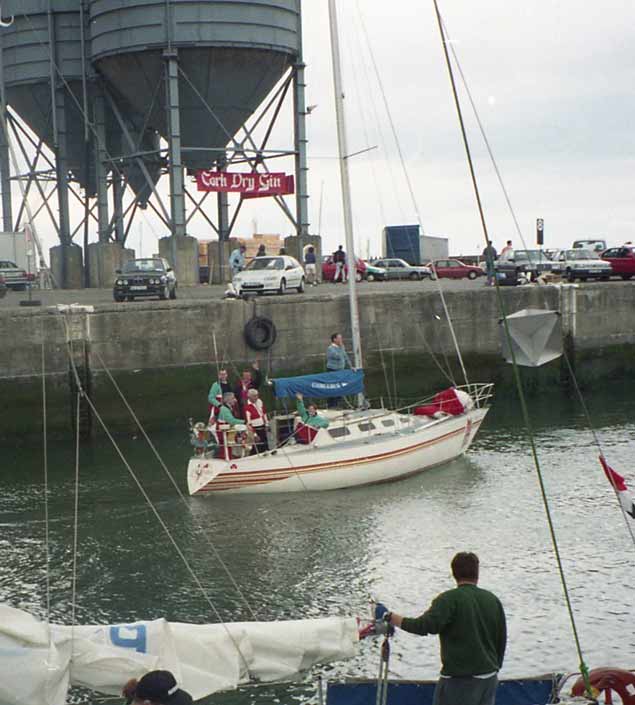 Emircedes (Michael Horgan & Peter Ryan) heading out of Wicklow port for the start of the 1994 Round Ireland race. Emircedes was one of the smallest boats in the fleet.
Emircedes (Michael Horgan & Peter Ryan) heading out of Wicklow port for the start of the 1994 Round Ireland race. Emircedes was one of the smallest boats in the fleet.
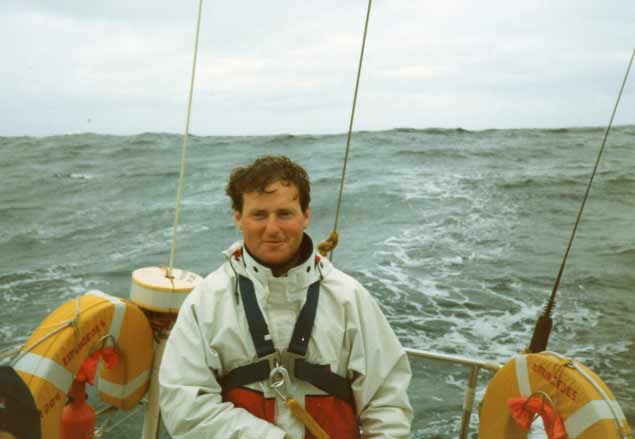 Small boat, big ocean – Peter Ryan enjoying helming Emircedes along Ireland’s Atlantic seaboard in the 1988 Round Ireland Race.
Small boat, big ocean – Peter Ryan enjoying helming Emircedes along Ireland’s Atlantic seaboard in the 1988 Round Ireland Race.
Despite that, there was something about ISORA which particularly appealed to Peter Ryan. He enjoyed the rhythm of its offshore races, and the idiosyncracies of each course. He was stimulated by facing the challenges that the weather and navigation of those diverse courses could provide. He cherished the cross-channel friendships the racing brought with it. He relished the opportunity to race against a fresh selection of boats, boats that he wouldn’t regularly see in the routine Dublin Bay Thursday evening racing. And he found something special in the way that any of the ISORA races which had started in Ireland would usually finish in Wales - though sometimes in the Isle of Man – thereby providing a rewarding way of going right to the heart of a new community.
But as different ways of enjoying leisure developed, and new expectations emerged of what family life entailed, a decline in local time-consuming offshore racing inevitably tended to see a falling away in ISORA numbers among the less-committed. It saddened him, but he was busy enough with the demands of the ever-more-crowded sailing and family programme based around Dublin Bay and the pillar offshore events, while his ability to get things done found him being targeted for one of the most demanding jobs in the voluntary sector of the National YC administration.
Boathouse Captain is a title with a certain ring to it, but properly done in those days, it was not so much a position of status as one of being in a demanding role, a real grind with much hands-on work to ensure the smooth working of the complex interface between the suave presence that a club like the National presents to the world at large, and the nitty-gritty of the way it helps to get its members afloat in boats large and small, plus how it serves their boats and moorings.
Peter Ryan was catapulted into this job for a three year stint in 2002 in the tough days before the National YC had a professional Sailing Manager. Although after a year or so he no longer had to deal with personal demands of boat-ownership and was to sail in due course with Vincent Farrell on the 2004 First 40.7 Tsunami, being Boathouse Captain was no sinecure. But with typical thoroughness he set to, quizzing the boatmen on how things were done, researching and implementing the improvements that were possible, and generally restoring the Boathouse functions to their central role in club waterfront life.
 Flying Fifteens and Wayfarer dinghies being brought ashore on the National YC slipway at the Volvo Dun Laoghaire Regatta in July 2017. As NYC Boathouse Captain from 2002-2005, Peter Ryan was directly involved in re-organising and modernising the club’s waterfront facilities and procedures. Photo: W M Nixon
Flying Fifteens and Wayfarer dinghies being brought ashore on the National YC slipway at the Volvo Dun Laoghaire Regatta in July 2017. As NYC Boathouse Captain from 2002-2005, Peter Ryan was directly involved in re-organising and modernising the club’s waterfront facilities and procedures. Photo: W M Nixon
He acquitted himself so well in the challenge that when Con Murphy became National YC Commodore in 2005, he brought in Peter Ryan as his Vice Commodore - a rocket-like promotion. Yet so highly were the new Vice Commodore’s abilities and achievements regarded that when he made an unusual request of the National YC Committee in the Autumn of 2005, they obliged him.
An extraordinary event – a wake of sorts - had been scheduled for the National YC in November 2005. Although Peter Ryan’s own enthusiasm for offshore racing was to be even further increased by the great joy of racing the First 40.7 Tsunami, interest in the annual ISORA programme was draining away so rapidly that the Chairman from the British side had decided that it was time to wind up the Association – he reckoned it had clearly outlived its usefulness.
A grand Farewell Dinner, black tie and all, was scheduled for the National YC in November, when some of ISORA’s 47 trophies would be given out to the few winners, while all the others would be returned where possible to the clubs or individuals who had donated them.
The totality of it came home to Peter Ryan when he saw the trophies being assembled in the weeks beforehand in all their historic glory. Some of them went back to races which were first sailed in the 1930s or even earlier. Yet somehow he’d a feeling that reports of ISORA’s demise were greatly exaggerated. And at a practical level, he realised that the re-assembly of the trophies in the event of a revival some time in the future would be an insurmountable task.
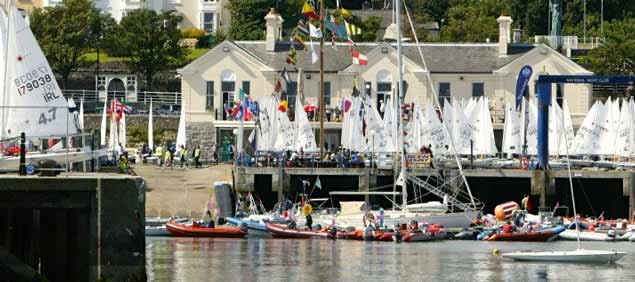 The National Yacht Club in Dun Laoghaire. Its Committee’s willingness to allow its office to be used as the base for ISORA saved the Association from being formally wound up in 2005.
The National Yacht Club in Dun Laoghaire. Its Committee’s willingness to allow its office to be used as the base for ISORA saved the Association from being formally wound up in 2005.
So he set about doing some groundwork to see if the National YC would be prepared to provide the administrative paperwork in those digital changeover days to keep ISORA ticking over, and he had this approval in place as D-Day for the Final Dinner approached. Then fate took a hand in an almost spooky way. An exceptional storm (even by Irish Sea late-autumn standards) meant no cross-channel ferries could sail. The funeral party from the English and Welsh contingents were unable to get across to Dun Laoghaire.
In their absence, the Irish contingent went ahead with the dinner. But it was emphatically no longer a wake. On the contrary, ISORA was re-born, and with Peter Ryan making an input with a realistic sense of what was possible, it has slowly revived ever since, and is now once again a nationally and indeed internationally-respected force in offshore racing.
 National YC Commodores at Peter Ryan’s end-of-term Commodores’ Dinner in 2011 are (back row, left to right) Brian Barry (1990), Michael Horgan (1993), Con Murphy (2005), Barry MacNeaney (1996), and Malachi Muldoon (1987). Front row Chris Moore (2002), Peter Ryan (2008-2011) and Ida Kiernan (1999).
National YC Commodores at Peter Ryan’s end-of-term Commodores’ Dinner in 2011 are (back row, left to right) Brian Barry (1990), Michael Horgan (1993), Con Murphy (2005), Barry MacNeaney (1996), and Malachi Muldoon (1987). Front row Chris Moore (2002), Peter Ryan (2008-2011) and Ida Kiernan (1999).
As for Peter Ryan, it was a case of a busy man getting ever busier. While quietly guiding the revival of ISORA with his effective mixture of under-stated determination and unrivalled knowledge of what the local offshore racing community requires from its sport, he had to continue for more than two years as NYC Vice Commodore, and then in 2008 he succeeded Con Murphy to take on the role of Commodore for three years as the great economic recession started to bite, with some of its most vicious effects reserved exclusively for Ireland.
But sailing life went on, albeit in muted style. Boats were still very much in being, even if they had to make do with sails no longer at their best. Yet as it happened, the fact that ISORA could provide accessible local offshore racing as economically as possible meant that its programme slowly revived and expanded despite the economic downturn.
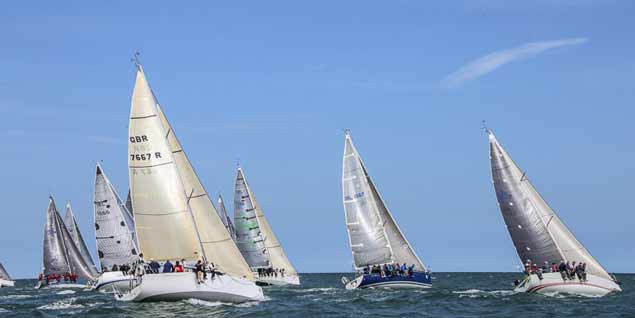 After the re-birth of 2005, ISORA numbers have been slowly but steadily increasing.
After the re-birth of 2005, ISORA numbers have been slowly but steadily increasing.
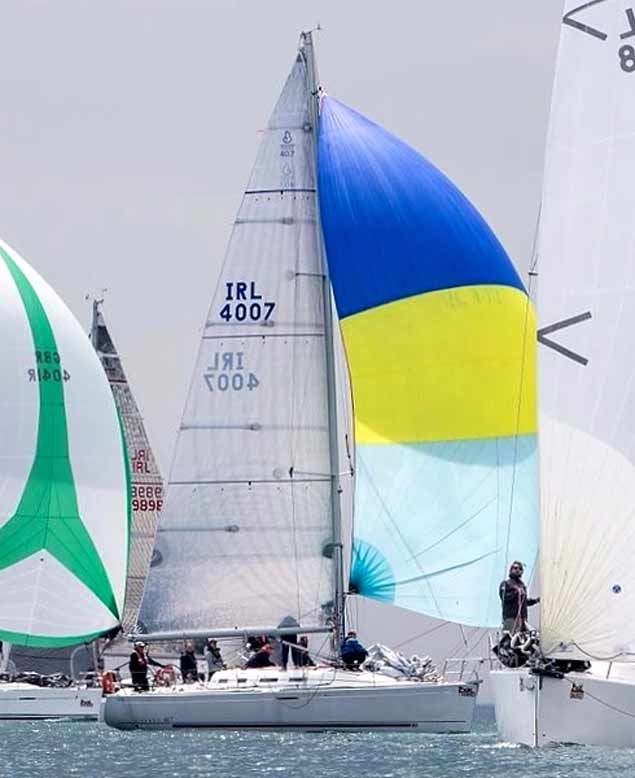 Vincent Farrell’s First 40.7 Tsunami, ISORA Champion in 2009 with Peter Ryan on board.
Vincent Farrell’s First 40.7 Tsunami, ISORA Champion in 2009 with Peter Ryan on board.
For Peter Ryan doing double duty as NYC Commodore and ISORA administrator, a very special year came in 2009 when he somehow found time to play a central role in Vincent Farrell’s First 40.7 Tsunami winning overall in the revived ISORA Championship in 2009. And though Tsunami has these days cut down on full-on offshore racing, Peter Ryan continues to campaign with her in DBSC and coastal races, while for the offshore stuff his growing treasure-hoard of cross-channel friendships has seen him filling regular crewing jobs on the Pwllheli-based J/109s Sgrech and Mojito, and he was on the strength of Sgrech for her overall victories in the 2012, 2013 and 2016 ISORA Championships.
 Stephen Tudor’s J/109 Sgrech, three times ISORA overall champion. He has a new J/111 for 2018.
Stephen Tudor’s J/109 Sgrech, three times ISORA overall champion. He has a new J/111 for 2018.
In fact, the role of the J/109s in the ISORA revival deserves praise – they were just what was needed when it was most needed, and duly received their reward. Stephen Tudor’s Sgrech won the championship from the Welsh side in 2012 and 2013, then Liam Shanahan Jnr’s Ruth from Ireland won in 2014 and 2015, while for 2016 and 2017 it has been back to Wales with Sgrech in 2016 and Vicky Cox and Peter Dunlop’s Mojito from Pwllheli (though they regard the National as their Irish home) who were feted at last November’s mega-dinner as the 2017 champions, albeit with the title being settled by the tiniest of margins in the final race.
Yet in all this friendliest of cross-channel rivalries, Peter Ryan’s extraordinary ability to get on with people and fit into a team has meant that he can transfer seamlessly from one boat to another. Thus although he was on the strength of Sgrech when she won the 2013 Championship, in that same year he also successfully participated in both the Dun Laoghaire to Dingle and Fastnet Races as a leading crewmember on Mojito.
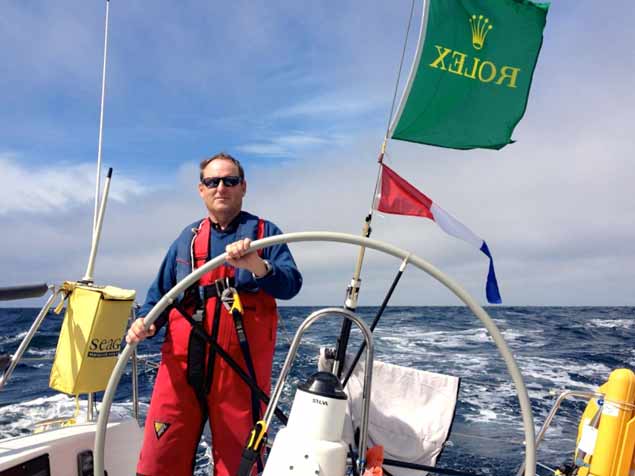 Dream sailing – fair winds and sunshine for Peter Ryan on Mojito’s helm in the 2013 Fastnet Race.
Dream sailing – fair winds and sunshine for Peter Ryan on Mojito’s helm in the 2013 Fastnet Race.
This breadth of experience helps to gives him a sort of sixth sense in gauging what ISORA crews expect from their programme, while he and co-administrator Stephen Tudor of Pwllheli (Peter is ISORA Chairman while Stephen is Secretary) have this almost telepathic relationship which enables ISORA to function effectively with a minimum of fuss through a programme which provides the maximum of racing with the least possible consumption of non-racing time.
 Stephen Tudor of Pwllheli – he and Peter Ryan are in tune on offshore racing. Photo: W M Nixon
Stephen Tudor of Pwllheli – he and Peter Ryan are in tune on offshore racing. Photo: W M Nixon
The Pwllheli skipper – in addition to his almost fanatical devotion to the cause of promoting his home port and the clear waters of Tremadoc Bay as a major sailing location – is renowned for his ability to maximize computer effectiveness. Thus we have this ten year parable for our time, whereby ISORA was saved in 2005 because the National YC was prepared to take on its administration through paperwork, but by 2015 it was thriving extremely efficiently because a successful owner-skipper in Pwllheli has a genius for modern computer-generated communication.
Yet that said, the old-fashioned ability to put a coherent account together immediately after the event is another key to ISORA-awareness, and Peter Ryan will willingly buckle down personally, and produce a report which speaks to participants and followers alike. It’s one of the many techniques he quietly employs to keep people interested, and think keenly of doing the next race in the series.
But all these management and communication skills would be much less effective were it not for the fact that Peter Ryan and Stephen Tudor are never happier than when they themselves are out racing offshore. They lead and inspire by example. Their quiet persuasion is underpinned by hugely-enjoyed action.
All that goes some way to explain why, just a dozen years after a dinner had been scheduled in the National Yacht Club for the doleful marking of the supposed demise of ISORA, in November 2017 Peter Ryan organised a joyful prize-giving dinner for 240 people from both sides of the channel at the same venue to celebrate a great ISORA year, and award those prizes which, back in 2005, had almost been scattered to the four winds.
 The Champion. 2017 ISORA overall winner Mojito in perfect racing trim
The Champion. 2017 ISORA overall winner Mojito in perfect racing trim
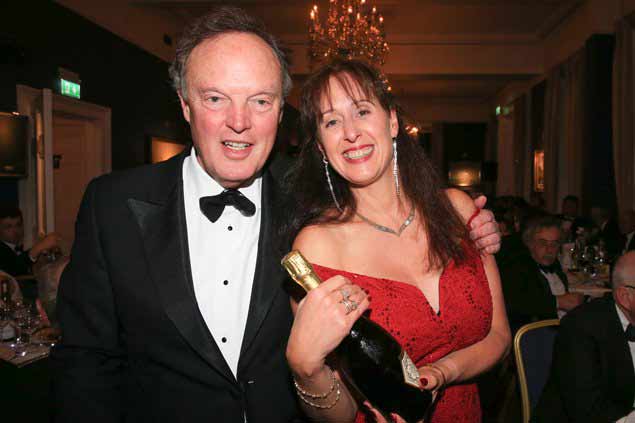 At the record-breaking November 2017 ISORA Prize-giving Dinner in the National YC, RORC Commodore Michael Boyd (left) was Guest of Honour to see Vicky Cox (right), co-owner of Mojito with Peter Dunlop, receive the overall champion’s prize. With an attendance of 240, this 2017 dinner was in marked contrast to an event just a dozen years earlier, when it was originally intended to wind up ISORA.
At the record-breaking November 2017 ISORA Prize-giving Dinner in the National YC, RORC Commodore Michael Boyd (left) was Guest of Honour to see Vicky Cox (right), co-owner of Mojito with Peter Dunlop, receive the overall champion’s prize. With an attendance of 240, this 2017 dinner was in marked contrast to an event just a dozen years earlier, when it was originally intended to wind up ISORA.
It may have been a deservedly boisterous celebration. But behind the scenes, it has all been brought about through dogged belief in an ideal, and quiet persuasion with a keen sense of what is possible and what works best. It’s effective offshore racing without fuss. The ISORA Programme 2018 gets under way in a week’s time, and our sailing scene would be greatly diminished without it.
Holyhead Storm Debris Washes Up South Of Dublin
#Holyhead - Debris from Storm Emma’s damage to Holyhead Marina has been found across the Irish Sea south of Dublin, as North Wales’ Daily Post reports.
Polystyrene from pontoons destroyed during the extreme weather event over a month ago was found in Greystones by a group of sea cadets from Holyhead.
“I was a bit shocked and I apologised to the people of Greystones,” said Lt Susan Williams with the sea cadet group, who added: “They were all sympathetic to what had happened and said it couldn’t be helped. Nobody was gunning for Holyhead but it was embarrassing.”
Holyhead marina users have expressed dismay over the progress of the clean-up operation over the last few weeks. The Daily Post has much more on the story HERE.
Holyhead Sailing Club Make Contingency Plans for ISORA Race Start After Storm Emma's Damage
Holyhead Sailing Club (HSC) is working on contingency plans to host the ISORA fleet following the devastation to the North Wales Marina during Storm Emma.
it is unlikely the damage will be repaired in time for the ISORA events planned in Holyhead this year but it is not stopping the HSC team from coming up with alternatives.
The ISORA start for race three on 12th May and also the finish of race four on 26th May are due to take place at Holyhead.
As Afloat.ie reported at the time, the damage in Holyhead both to its racing fleet and the marina pontoons was severe.
New Jeanneau Sunfast 3600 'Yoyo' Debuts at Dun Laoghaire Marina
The ISORA fleet's newest arrival, a brand new Jeanneau Sunfast 3600 named Yoyo, made its debut at Dun Laoghaire Marina this weekend and although only partially commissioned by MGM Boats at this point, the Daniel Andrieu design looks more than ready for the first race of the ISORA calendar next month.
As Afloat.ie readers will recall, the twin rudder yacht arrived into Dun Laoghaire Harbour last month and is a sistership to the hugely successful BAM! from Howth Yacht Club.
Adapted to solo, doublehanded, and crewed regattas, the Sun Fast 3600 is designed to compete in both inshore and offshore races.
The first ISORA race of the season is a 40–mile coastal shake–down on April 21st.
Yoyo is berthed at the end at the entrance to Dun Laoghaire marina and she's well worth a look. The starting price for such a boat is €172,000 including VAT but excluding sails and delivery charges. Temptingly, an MGM Boats notice displayed on a stanchion says 'two more available for this season'....
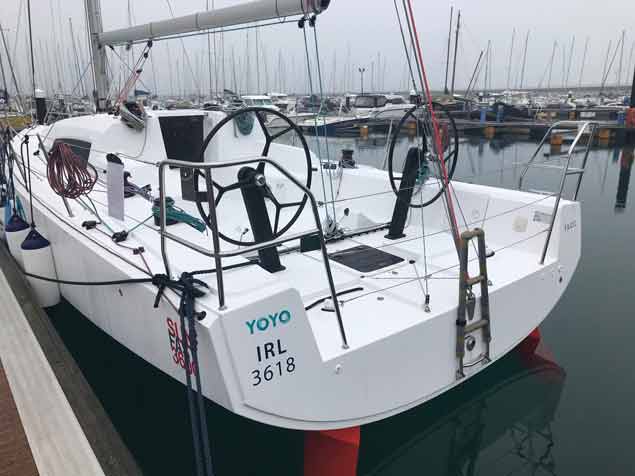 YoYo is set up with a twin wheel configuration. Available with twin, composite tillers or wheel steering and choices in mainsheet management, the SF3600 deck layout ensures easy handling through well thought-out ergonomics and optimised sailing functions
YoYo is set up with a twin wheel configuration. Available with twin, composite tillers or wheel steering and choices in mainsheet management, the SF3600 deck layout ensures easy handling through well thought-out ergonomics and optimised sailing functions
Holyhead Marina & Yachts Devastated By Storm Emma (Video)
Force 12 winds that battered Holyhead Marina, Anglesey have left the marina 'in bits' and boats berthed in the North Wales facility are reported as 'lost'.
The sad scene became apparent at first light this morning. It is understood yachts in the marina that were involved in the winter racing series were sunk and there is very little left of the marina itself.
The video below was taken at 08:38 this morning.
The Holyhead lifeboat was moved to the inner harbour for continuing service.
BAM! Jeanneau Sistership Unveiled by MGM Boats in Dun Laoghaire Harbour
Just as the Jeanneau Sunfast 3600 success story that is BAM! celebrates yet another victory in the West Indies this weekend, a sister-ship is being unveiled in Dun Laoghaire Harbour by Irish Jeanneau dealers MGM Boats.
The new Dublin Bay arrival is a welcome addition to the Irish racing fleet that will most likely be seen first racing on the ISORA circuit, according to Afloat.ie sources. The first ISORA race of the season is a 40–mile coastal shake–down on April 21st.
The 2018 Irish Sea schedule runs right through to the end of September with 15 races in store thus giving plenty of time for the return of this week's Caribbean 600 class champion to line up against her new rival at a time when ISORA numbers are buoyant.
Afloat.ie understands the new 3600 is almost identical to BAM! with a sail wardrobe by North Sails Ireland. One big difference between the two boats, however, is the new owner has opted for a double wheel configuration instead of BAM's tiller arrangement.
The new boat is expected to be sailed mostly fully crewed or double-handed.
The boat, commissioned by MGM Boats this week, includes a spray finish antifoul by the boatyard.
ISORA Offshore Sailing Numbers Close to All Time High, 2018 Racing Schedule Announced
2017 was the best season for Irish Sea offshore racing (ISORA) in many years with 68 boats taking part in the 15-race series writes ISORA Chairman Peter Ryan. In 2016, 54 boats took part. To put these numbers in context, in 1978, when ISORA was in its “hey-day”, 70 boats raced with an average race entry of 32 boats. We are very close to this again and I am confident that those numbers will be exceeded in 2018.
The ethos of ISORA is to provide challenging and satisfying offshore and coastal races for its members and, just as importantly, provide a convivial social scene for those skippers and crews who take part. What is unique about the boats who participate in ISORA is that while they are extremely competitive during races the camaraderie that exists between all skippers and crew, ensures that assistance and encouragement is offered to competing boats at all times. Safety within the fleet is paramount.
A 15 race schedule is planned for 2018 that will include 7 offshore races, a 4-race coastal series on the Irish side and a 4-race coastal series on the UK side. The Round Ireland, although the offshore racing apex of the season, is not included in the overall ISORA Offshore Series but ISORA will be presenting prizes and trophies to ISORA boats taking part in this epic race.
The race schedule has been compiled to minimise clashes with other events and to work with these events where possible. To this end ISORA will be working with Liverpool and Tranmere Yacht Clubs on the Midnight Race, Howth Yacht Club on the Lambay Race and Wicklow Sailing Club on the Round Ireland. There is also a delivery race to the Spinlock IRC Welsh National Championship
ISORA will be running an offshore weekend on the 8th-10th June that, together with deliveries, will allow a boat and crew to qualify for the Round Ireland in one weekend. This weekend consists of the Midnight Race from Liverpool to Douglas on the Friday evening and a race from Douglas on the Sunday morning.
The full schedule advertised in the Afloat Irish Sailing Annual is downloadable below.
ISORA will be organising a pre-season coastal race on the 14th April from and back to Dun Laoghaire. Although not part of the ISORA Series, prizes will be presented after the race. It is hoped that this introductory race will attract new boats that have not yet taken part in ISORA. A party will be organised in the NYC after the race for all participants and members.
Anyone interested in entering ISORA or considering crewing on an offshore boats can contact Peter Ryan at [email protected]
Howth Yacht Club's 'New Wave Regatta' a Dynamic Mix of Old and New
A successful new development in the national sailing programme will inevitably be something of a revolution. Yet if those managing the event handle it in the right way, the changeover can take place without people thinking that anything really revolutionary – in the sense of a sudden and complete change – has taken place. W M Nixon takes a look at the successful unveiling of the new-style Wave Regatta planned for his home port of Howth for next year’s June Bank Holiday Weekend.
Preparation is everything. Quiet work behind the scenes in trying to visualize every practical and administrative glitch which might arise, and how best to deal with it well before it becomes a problem, is essential. Getting key people – decision-makers and can-do people, local, regional and national – firmly on side, is absolutely essential.
Testing the waters of consumer opinion with trial announcements and proposals, and the occasional test run maybe disguised as something else, is also part of the process. Yet revealing too much of what is taking shape before it is really ready to go public can do more harm than good.
Thus when Howth Yacht Club’s Wave Regatta 2018 was unveiled after a crisp and businesslike Annual General Meeting in the clubhouse on Thursday night, not only was it a very complete and appealing concept in itself, but it emerged fully formed, and in a style well presented to an audience filled with fresh enthusiasm.
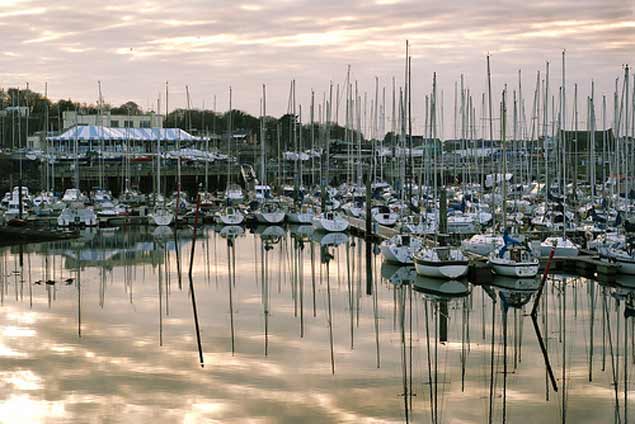 Howth’s modern marina/clubhouse complex (above) is in stark contrast to the situation pre-1987 (below) when the ISORA racers and the fishing fleet had to share the same small space. The boat at centre is the famous S&S-designed Sunstone (Tom & Vicky Jackson) which in her racing days with ISORA was known as Dai Mouse III.
Howth’s modern marina/clubhouse complex (above) is in stark contrast to the situation pre-1987 (below) when the ISORA racers and the fishing fleet had to share the same small space. The boat at centre is the famous S&S-designed Sunstone (Tom & Vicky Jackson) which in her racing days with ISORA was known as Dai Mouse III.
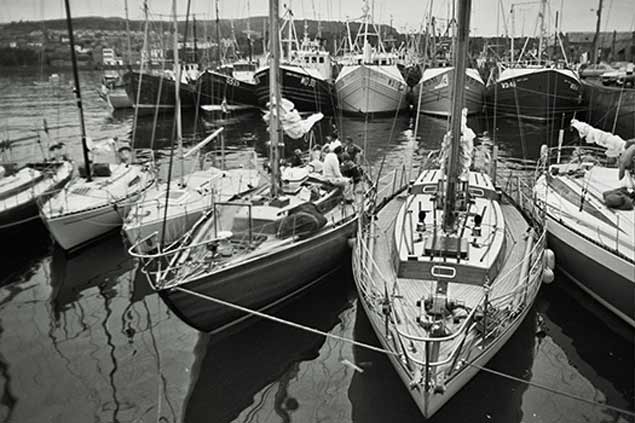
After all, Commodore Joe McPeake had just finished chairing an AGM whose mood was enthusiastic after the publication of a set of figures which showed that the huge extra voluntary effort and support which the club has received from many of its members during the past 18 months has paid real dividends. While the improving mood had become increasingly apparent as the season progressed, by Thursday night if you could somehow have linked it to the National Grid, you’d have lit the village with it.
Inevitably, Howth gets compared to the big southside clubs of Dun Laoghaire, and the way their huge reservoir of personnel resources - further augmented by the overall administration of Dublin Bay Sailing Club, and with the large marina run as a commercial venture – frees up a enormous pool of talent to keep a high-powered show on the road. For when all is said and done, only Dun Laoghaire - with its unique selection of stately shoreside facilities - could stage an event like the Volvo Dun Laoghaire Regatta.
But in Howth, the one club has to do everything. So instead of trying to rival Dun Laoghaire, today’s Howth sailors see their strength in being themselves in their own special peninsular port, which is neither Dublin nor northside nor remotely southside. On the contrary, it’s emphatically part of Fingal. And it’s indisputably Eastside. On top of all that, as its basic geology is twice as old as anywhere nearby, it is Ireland which is the add-on to Howth, rather than the other way round.
However, that’s not in anyone’s mind in Howth at all this weekend, as we realize the leap of the imagination which has transformed some long-established Howth events by combining them with new concepts, and then steering the whole package into a significant gap in the market which had been hidden there in plain sight for all to see.
For the overall shape of the 2018 National Sailing Programme is unusual. The biennial Volvo Round Ireland Race from Wicklow has been shifted to the last weekend of June, presumably because its time-honoured slot right on the mid-summer weekend around June 23rd would have clashed with the finish of the Volvo Ocean Race itself in The Hague at the same time.
So with the Volvo Round Ireland on June 30th, Volvo Cork Week in its turn was moved back to July 16th to 21st. And while those who seek a fun regatta with holiday overtones have Calves Week in Schull from August 7th to 10th, those in pursuit of racing with recognised national titles at the end of it have the ICRA Nationals at Galway from 15th to 18th August.
What it meant to those in Howth was that there wasn’t a major cruiser-racer championship on Ireland’s East Coast for the entire season, and particularly not in June and early July when the heavies generally expect an event of this type. But that realisation came after they’d already set in motion a project to re-invigorate their traditional Lambay Race, which has been staged annually since at least 1904 and maybe earlier.
 The classic Lambay Race. Howth 17s Aura and Pauline racing along the coastline of Ireland’s most unspoilt island. Photo John Deane
The classic Lambay Race. Howth 17s Aura and Pauline racing along the coastline of Ireland’s most unspoilt island. Photo John Deane
In times past, with smaller craft such as the 1898-established Howth 17s (happily still with us, and stronger as a class than ever), simply racing round the island of Lambay from Howth was enough for a long day’s race. But with newer and much bigger craft joining the mix, all sorts of ways had to be found to increase the length of the Lambay Race for the big boats, while retaining its character. Yet by this stage, the programme generally was becoming crowded, with the revival of ISORA posing new problems of rival events.
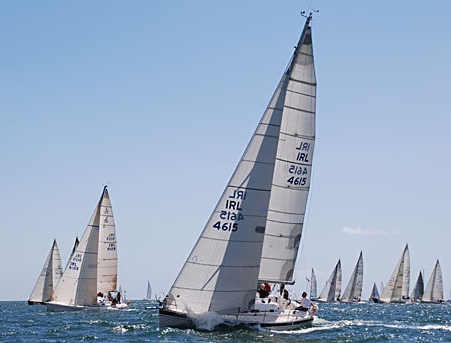 Cruiser-racers in the Lambay Race. Todays faster boats expect a longer race than the traditional 16-mile course
Cruiser-racers in the Lambay Race. Todays faster boats expect a longer race than the traditional 16-mile course
A partial solution was reached this year when the ever-obliging ISORA Chairman Peter Ryan agreed to incorporate the annual Lambay Race as the main section of an ISORA Race which would start with the Lambay fleet and sail through its course and finish line, but then race on to a finish in Dublin Bay to provide the kind of distance ISORA expects.
However, for 2018, the Lambay Race on Saturday June 2nd will be a fully-fledged ISORA event in its own right. But it will literally be a Lambay-Race-With-Knobs-On for the Cruiser-Racer classes, as the organisers are planning a morning start and probably taking in Rockabill and the Kish to provide a perfect miniature offshore course.
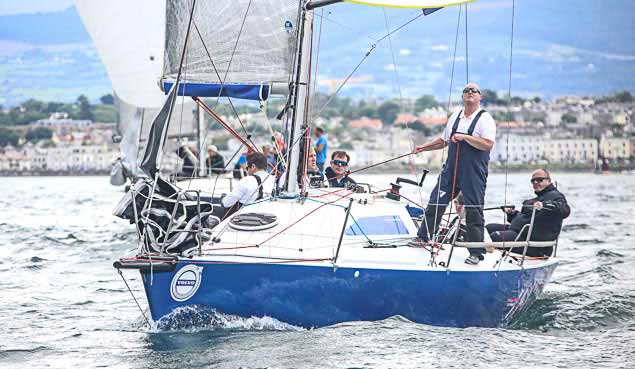 Dave Cullen, Director of Racing for the Wave Regatta, on the tiller of his classic Half Tonner Checkmate XV. Photo: Afloat.ie/David O’Brien
Dave Cullen, Director of Racing for the Wave Regatta, on the tiller of his classic Half Tonner Checkmate XV. Photo: Afloat.ie/David O’Brien
Having the full ISORA imprimatur on this extended Lambay Race provides the new Wave Regatta with the massive corner-stone which enables the Organising Committee, chaired by former HYC Commodore Brian Turvey, to build a full three-day programme around it, for they can be confident that local One Design Classes such as the Puppeteer 22s and the Howth 17s will already be doing the Lambay Race in its traditional form. As well, Sportsboat Classes like the SB20s and the 1720s will also have the option of a start. And if the IRC Class divisions are made in the right way, we’ll have the J/109s, the J/80s and the J/24s racing as classes-within-classes to add that bit of extra zing.
As the possibilities became clearer, one extra bit of information encouraged the Howth group to go for it big time in promoting an event with three days of solid racing as a viable biennial alternative to the Volvo Dun Laoghaire Regatta. This was the news that, in future, in every even year the annual ICRA Nationals will be staged at a non-Dublin venue – August’s Galway venue is the start of this process.
This meant that the Howth team really had to get their skates on in order to have a realistic proposition and programme in place in time for an official unveiling at Thursday’s HYC AGM on December 14th. Even with test runs on various aspects of the main idea during the past couple of seasons, the actual countdown time was short enough, but by Thursday night such a complete package could be put on display that they were able to tell us that Fingal County Council were giving major support, there was every encouragement from the Harbour Authority, and HYC member Michael Wright had come on to the Committee to act as shoreside hospitality director, while also bringing in the support of his Wright Hospitality Group.
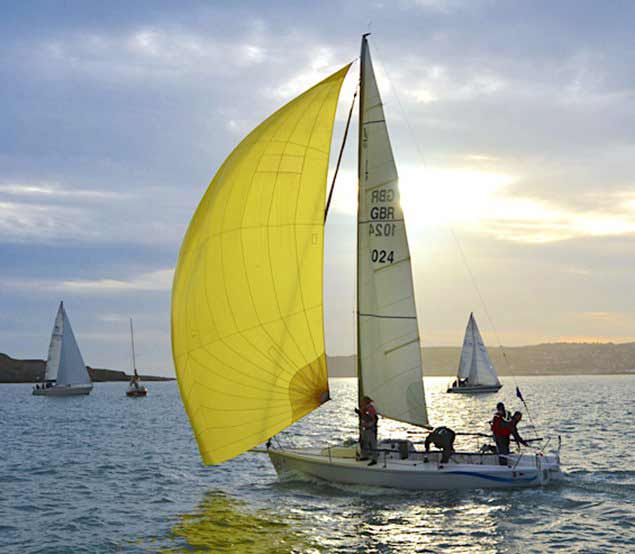 One of HYC’s club-owned J/80s in Howth Sound. With an additional club-owned flotilla from the Royal St George YC, the IRC-compliant J/80s will have a choice of options for Wave Regatta
One of HYC’s club-owned J/80s in Howth Sound. With an additional club-owned flotilla from the Royal St George YC, the IRC-compliant J/80s will have a choice of options for Wave Regatta
In fact, these days with its proliferation of characterful restaurants and hospitality hotspots, Howth’s shoreside entertainment is soon in place. So it’s the programme afloat which has to match it, and here the organisers have hit the target by having Irish Sailing President Jack Roy take on the role as one of the senior Race Officers, another being former President David Lovegrove. Howth-based Race Officers such as David Lovegrove and Harry Gallagher have long made a major input into Volvo Dun Laoghaire Regatta, so all these top men afloat are accustomed to working with each other in the most demanding situations.
They’re also accustomed to inter-acting with the “customers” after racing, and it was their reports of overseas visitors to the Dun Laoghaire Regatta expressing a wish to take part in some sort of major event in the Greater Dublin area every year which encouraged the Howth team to think that, with proper planning, they could provide an alternate biennial regatta which would be different from Dun Laoghaire, yet express the same mood of good but not too serious sport afloat, and high-powered entertainment ashore, with an emphasis on attracting younger participants.
 Irish Sailing President Jack Roy will be a Race Officer at Howth’s new event
Irish Sailing President Jack Roy will be a Race Officer at Howth’s new event
Flexibility is the approach. For those who wish to do just the Lambay Race on the Saturday, that’s fine. But for those who want the Full Irish of a really good programme of sport, there’ll be three races on Friday 1st June, and three more on Sunday June 3rd, while the Bank Holiday Monday will be given over to a Family Day which was very popular in 2017, and will be further developed next year.
As with everything to do with sailing in Ireland, the weather factor will be considerable. But for those of us who have done more than a few Lambay Races, the good memories linger best, and they’re of an effortless regatta atmosphere with an element of local pride, for it’s the coast of Fingal we’ve been racing along, one of all Ireland’s finest islands we’ve been racing round, and it’s our own home port under the hill that we’ve raced home to.
Which makes it fine for those who live locally. But the Wave Regatta Committee, in which Dave Cullen plays a key role as one of the leading ideas experts while officially he’s called Director of Racing, realise that the fact of Howth being on a peninsula and the village being largely residential, with a shortage of hotel bedrooms, can provide a challenge for those who live elsewhere, but want to keep their boats race-ready rather than as floating caravans.
So HYC have hired 30 campervans which will be available for rent in the car-park beside the club, and as well local sailors have made it clear they’ll be more than hospitable in providing accommodation. As for the problem of the DART from Dun Laoghaire not starting until late on a Sunday morning, they’ve swung a deal with Dublin Bay Cruises whereby the familiar blue-hulled St Brigid will depart her berth in Dun Laoghaire at 08:15 Sunday morning, bound for Howth and the final day of racing.
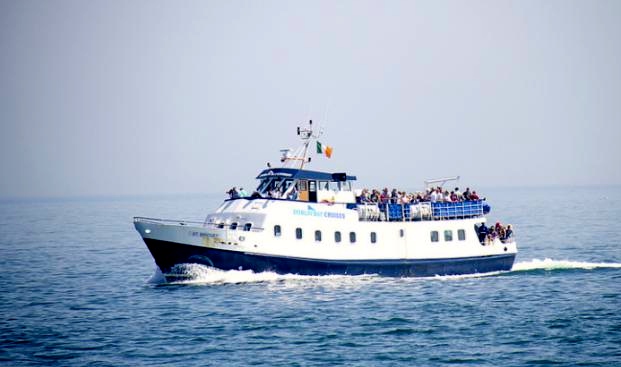 The Dublin Bay Cruise vessel St Brigid will run a ferry service from Dun Laoghaire to Howth on the Sunday morning
The Dublin Bay Cruise vessel St Brigid will run a ferry service from Dun Laoghaire to Howth on the Sunday morning
It’s that sort of off-the-wall yet actually very sound idea which gives us some idea of the thought which is going into this new Wave Regatta at Howth. You can do a lot of sailing in three days if everything is in place, and this team is determined that it will be.
Meanwhile, let’s hear it for the home squad, the new HYC Club Officers who were elected on Thursday night, and will have their agenda will filled throughout their time in office, as plans for 2018 include the establishment of a fully-fledged Sailing School within the club. They are: Commodore: Joe McPeake; Vice Commodore: Ian Byrne; Rear Commodore: Paddy Judge; Rear Commodore: Ian Malcolm; Hon. Secretary: Bernie Condy; Hon. Sailing Secretary: Caroline Koster; Honorary Treasurer: David Mulligan.
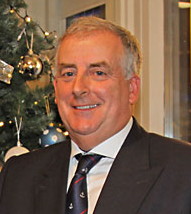 HYC Commodore Joe McPeake
HYC Commodore Joe McPeake
David Whitehead 1942-2017
Irish sailing is mourning the loss of someone very special with the death of Dave Whitehead of Kinvara. In his close and strong family circle, throughout an international circle of friends, and among many more in the Galway Bay area, the loss is made more poignant by the fact that he was a very active 75–year-old, brimming with plans for the future, and keenly interested in every aspect of the world today, both within and beyond sailing.
His life story is a tale of our times. From Monkstown in County Dublin, he was of a technically-minded family – a great-grand-uncle had invented the Whitehead Torpedo, the first in the world. Young David had started his sailing in Dublin Bay, but after graduating in geology from Trinity College, his career path was in mining, which eventually took him to many corners of the globe, some of them very remote, and others also very far underground.
However, an early position in the late 1960s was with Tynagh Mines in the southeast of County Galway, headed by Dave FitzGerald who shared his love of sailing. For a while they were much involved with the little sailing club which functioned at the time on the lake at Loughrea. But the call of the sea and the possibility of a club being established on Galway Bay drew their sailing interests westward, and during the early 1970s David Whitehead contributed much to the early life of Galway Bay Sailing Club, which was being spearheaded by determined enthusiasts like Pierce Purcell and others.
Dave had maintained his friendships with Dublin Bay sailing, and through John Bourke with Jack McKeown’s S&S 34 Korsair, he was able to introduce the new sailors of Galway, who at that time were experimenting with being based on Lough Atalia immediately east of the city, to the invigorating realities of offshore racing with ISORA.
Dave himself was soon to go on to become elected to both the Irish Cruising Club and the Royal Ocean Racing Club. But meanwhile in Galway the neophyte club accepted his and David FitzGerald’s advice that they should locate their main sailing base at Renville near Oranmore at the head of Galway Bay, and soon Dave Whitehead was making an active input to the GBSC as a sailor who introduced some interesting craft to the growing fleet at Renville, and as a member of the committee.
 Always absorbing information. Dave Whitehead taking on board some new facts while on passage from the Azores to Ireland in 2008. Photo: Ed Wheeler
Always absorbing information. Dave Whitehead taking on board some new facts while on passage from the Azores to Ireland in 2008. Photo: Ed Wheeler
The Honorary Secretary in those early days was Marie White, and in each other they found kindred spirits, and were married. They shared the hope that they would live in due course on the shores of Galway Bay, but to achieve that Dave first had to see through a very concentrated international career in mining. In this, with Marie’s support, he was very successful, working extremely hard both in the field and in board-rooms, rising rapidly through the ranks to achieve positions of significance in the leading global commodities firm Billiton – at the time of his death last week, he was chairman of a number of Billiton’s London-based subsidiaries.
He and Marie had long since also succeeded in returning to Galway Bay, buying The Glebe in Kinvara and turning it into an idyllic family home. As for sailing, his interest was if anything greater than ever, and though he had always made a point of finding the best sailing within reach of wherever his various mining jobs took him, his heart was with Galway Bay, where he went though an intriguing array of boats ranging from the Quarter Tonner Frantic aboard which many young GBSC sailors took their first steps afloat, to the classic miniature S&S 27 Shemite – all of them boats which have remained with the Galway Bay fleet under new owners.
One he’d achieved his dream of finally settling in the west (where, during his and Marie’s absence abroad, the members had built the first GBSC clubhouse at Renville in 1979) Dave Whitehead was able to put experience gained at many other sailing centres to good use. Though he’d never had any formal training in race management, Pierce Purcell fondly recalls that he proved a natural as a Race Officer, providing his services with enthusiasm, and running things afloat very competently and without fuss.
But by now his main enthusiasm in sailing was in cruising, while in life generally it was about learning even more to add to the huge stock of knowledge in his already well-furnished brain, and its deployment on the lively discussions which he relished. Fellow Irish Cruising Club member Ed Wheeler, himself no slouch when it comes to conversations in depth, recalls a voyage home from the Azores crewed by Dave: “The wind-driven autohelm was working very well, so inevitably at mealtimes, and indeed at many other times, there were discussions as we sailed along. You might think you had talked Dave around to your way of thinking, but then he would come up with some totally unexpected but indisputable and perfectly-remembered scientific fact from his warehouse of mental information, and the argument was back to square one”.
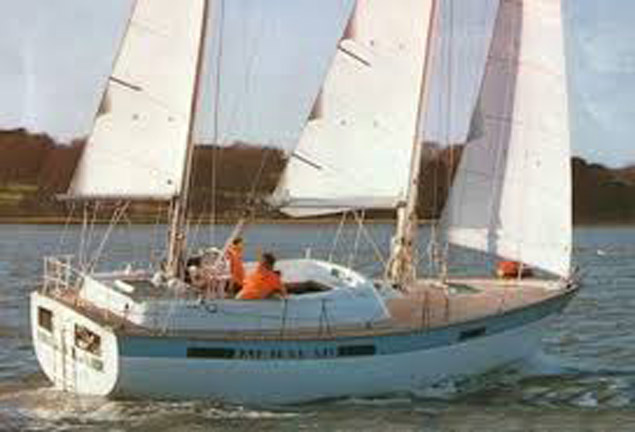 The unusual dreamship. While Dave Whitehead’s smaller gunk-holing craft were often of traditional appearance, much of his offshore cruising was done with the highly-individual Oyster Mariner 35 Joyster, a Holman & Pye design which packed an astonishing amount of accommodation into a compact hull which performed very well
The unusual dreamship. While Dave Whitehead’s smaller gunk-holing craft were often of traditional appearance, much of his offshore cruising was done with the highly-individual Oyster Mariner 35 Joyster, a Holman & Pye design which packed an astonishing amount of accommodation into a compact hull which performed very well
Typically of Dave Whitehead, when making a Transatlantic passage as crew with Marie aboard La Contenta in the ARC of 2003, the very fact of the boat being well equipped with the latest in electronic navigation aids prompted him to bring along traditional bits of gear to calculate their position, and by the end of the voyage not only was he getting his calculations absolutely spot on, but he had worked out ways of simplifying the time-honoured methods used by the likes of James Cook and other great voyagers.
For his own principle cruising boat, he was for many years content with the ingeniously-laid-out Holman & Pye-designed Oyster Mariner 35 ketch Joyster in which he voyaged near and far, and was rewarded with ICC and GBSC trophies. But from the moment he settled in Kinvara, he was also fascinated by the miniature cruising possibilities – the “gunk-holing potential” – of the much-indented southern and eastern shores of Galway Bay. To explore them properly, he went through an almost bewildering variety of small specialist cruisers with lifting keels and easily-handled rigs which enabled him to get to places where no cruising boat had ever been seen before.
With his base now in Kinvara, he could also contribute to the changes in the perceptions in the rest of Ireland of the level of sailing in the west, and together with Dave FitzGerald, he was much involved in a major re-balancing of the structure of the Irish Cruising Club. This began with an increase in western-based Committee members, then there was a western Rear Commodore, and eventually Dave FitzGerald served as Commodore from 2000 to 2002, while Dave Whitehead was Rear Commodore from 2006 to 2008, and Vice Commodore from 2009 to 2011.
In his later years, he made the shrewd judgment that the unpretentious but very cleverly-designed Moody 27 was the ideal boat for his main cruising needs, while continuing to work with specialists like boat-builder Tiernan Roe of Ballydehob in West Cork towards creating the perfect gunk-holing cruiser for places “where the water is very thin”.
In sailing the Moody 27 Mystic, he found an ideal crew in the equally individualistic Peter Fernie who lives on Tawin Island, which is well out in Galway Bay, though connected by a causeway to nearby Ireland. As matched spirits, they moved into an ownership partnership which worked very well, and a round Ireland cruise with an extended visit to the Hebrides in 2016 saw them being awarded GBSC’s David Baynes Cruising Award in the face of some formidable competition.
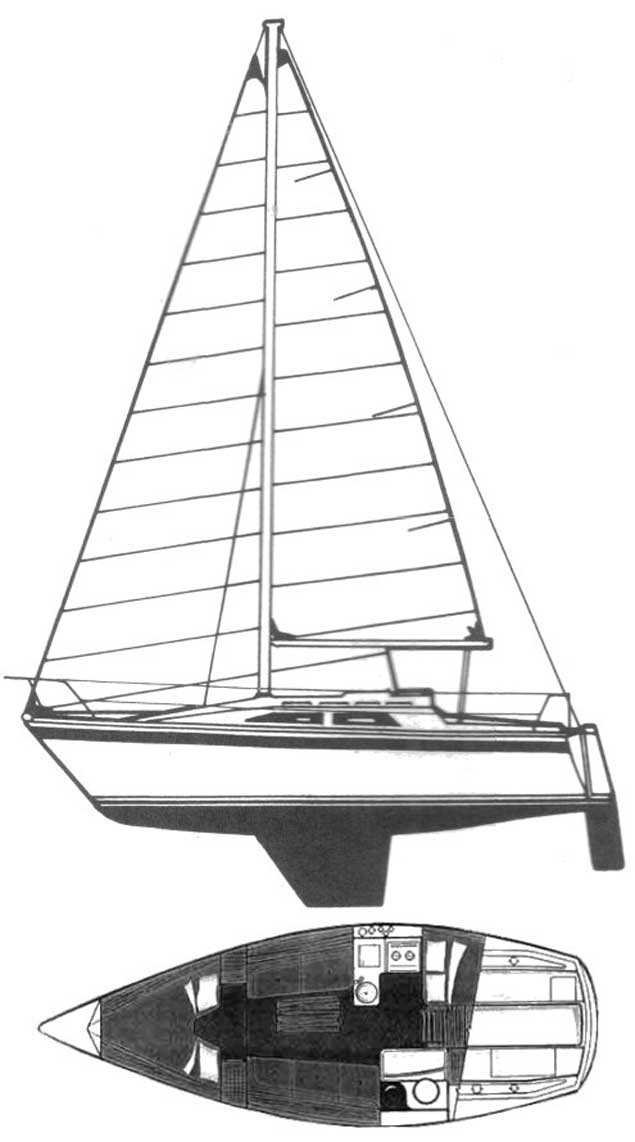 David Whitehead’s last seagoing cruiser was the Moody 27 Mystic, which he latterly co-owned with Peter FernieIt is Peter Fernie’s response to the death of David Whitehead which best captures the essence of this remarkable man, and with his permission, even though it re-phrases some of what we’ve already said, we are honoured to publish it here:
David Whitehead’s last seagoing cruiser was the Moody 27 Mystic, which he latterly co-owned with Peter FernieIt is Peter Fernie’s response to the death of David Whitehead which best captures the essence of this remarkable man, and with his permission, even though it re-phrases some of what we’ve already said, we are honoured to publish it here:
“David Whitehead: A memoir by Peter Fernie
David Whitehead was never lost for words. Whether it was boats, or maritime history in general, mountaineering or rugby, climate change or electric cars, you could be certain that David would have a well thought out position. More often than not, his was a contrary one to the accepted or establishment view, but a position backed up by his incomparable memory.
Despite his losing keys and mobile phones like the rest of us, I often wondered whether David had ever forgotten anything he had read or seen in the past. His prodigious recall was exemplified once when sailing up the Cleddau River in Wales, above Milford Haven. This location was not part of our plan, but we had ended up there en-route to Brittany, owing to a number of engine-related difficulties. David spied a moored wooden cutter, and we sailed across to get a closer look. Triumphantly he said: “That’s Driac” and proceeded to give me a detailed history of the 1930s Nicholson built boat: her original owner and cruises, as well as various assorted related ephemera comprising the establishment of the National Maritime Museum in Greenwich, and the evacuation of the B.E.F. from Dunkirk. I always assumed that he had this stuff printed on the back of his eyelids. In the event I googled Driac when I got back home – he was absolutely accurate.
Moving to Galway in the ’60s, he had sailed up and down the west coast and further beyond with David Fitzgerald (ICC). His training as a geologist found him working with mining concerns around the world but wherever he was, he found time to sail. He was a founder member of Galway Bay Sailing Club and became a member of the Royal Ocean Racing Club and the Irish Cruising Club in 1972. He became a member of the Royal Cruising Club in 2008.
He had raced and cruised many different boats since his days in Trinity College, Dublin. He had owned boats large and small from his first, a 16 foot Paul Gartside designed gaffer to his latest, Goblin, a 16 foot Chesapeake Bay microcruiser which he adapted for gunkholing around Galway Bay creeks.
In 2009 whilst Vice Commodore of the Irish Cruising Club, he was diagnosed with lung cancer which he attributed to working in an Australian uranium mine. Nevertheless, and despite major surgery he was sailing his Oyster Mariner 35 Joyster three months later to Tory Island and Lough Swilly. Despite a continually compromised respiratory system, David never let this get in the way of his sailing, with cruises to Wales, Brittany, the Isles of Scilly and the Aeolian Islands as well as the south and west coasts of Ireland. In 2016 we sailed from Galway to the Hebrides and back around Ireland clockwise to Galway in our Moody 27 Mystic.
This year, he was sailing in Galway Bay several days before a forthcoming hip replacement operation. Next year was to be an extended cruise to Galicia, as well as a gunkholing cruise in Roaring Water Bay.
He was an excellent shipmate and a great companion. He could be uncompromising and pedagogic but was never boring. He was unremittingly positive about life and dwelt always on the future whilst enjoying the past. He will be missed by many”.
Our heartfelt condolences are with David Whitehead’s wife Marie, his son Duncan, his daughters Jennifer and Siobhan, his daughter-in-law Kerry, his grandchildren, and his extended family and very many friends. May he rest in peace.
WMN
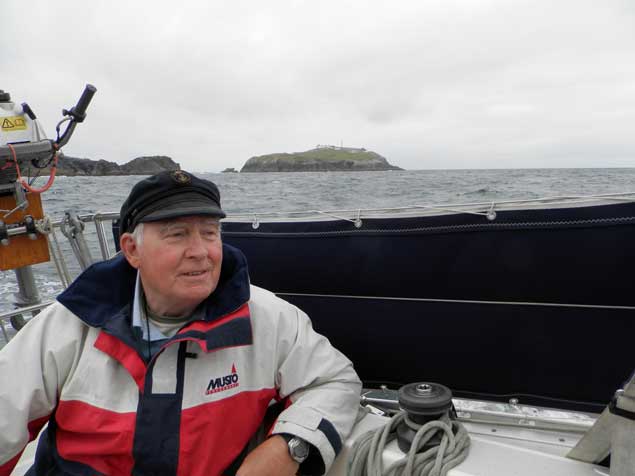 The last major cruise. Dave Whitehead at the helm of Mystic in June 2016, emerging from Broadhaven in Mayo, bound for the Hebrides with Eagle Island to seaward. Photo: Peter Fernie
The last major cruise. Dave Whitehead at the helm of Mystic in June 2016, emerging from Broadhaven in Mayo, bound for the Hebrides with Eagle Island to seaward. Photo: Peter Fernie
240 Pack National Yacht Club to Celebrate ISORA Awards Dinner
240 ISORA competitors and guests attended the 2017 awards ceremony and dinner at the National Yacht Club in Dún Laoghaire last Saturday writes Mark Thompson.
ISORA chairman Peter Ryan kept the evening on track, with awards of both the perpetual trophies and crystal glassware to the top three placed boats in all three fleets, plus prizes the individual results for all competitors in the 14 races series which started in April, and culminated in the season defining “James Eadie” 75 mile race from Pwllheli to Dún Laoghaire which this year decided the ISORA overall champion.
It was a great pleasure to see Peter Dunlop and Vicky Cox (J109 Mojito) receive the prestigious “Wolfs Head” Trophy from Peter and Anne-Marie Ryan crowning them 2017 champions
Sailors and guests were treated to a champagne reception, followed by an outstanding four course meal devised and cooked by head chef Cormac Healy, served with fine wines and Jack Ryan 'Beggars Bush' whiskey to finish.
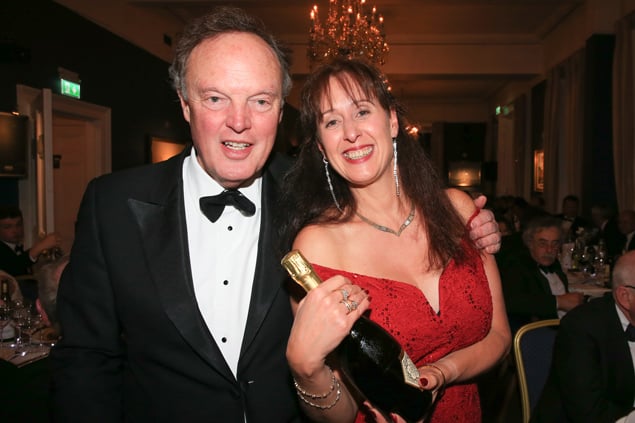 Michael Boyd and Vicky Cox Photo: GP Foto
Michael Boyd and Vicky Cox Photo: GP Foto
Michael Boyd RORC Commodore and ISORA guest delivered a humorous story of how the Lyver Race medallions managed to stay at his house, and generously bought Champagne for all the Lyver race competitors present.
Other notable awards during the evening were the 2017 Spirit of ISORA “Penmaen Plate” awarded to Charlene Howard who raced “AJ Wanderlust” very consistently all year, often two handed and being based in the Isle of Man faced the greatest number of deliveries. Indeed Charlene and her crew even sailed over for the awards Dinner!
The Silver fleet and IRC class 2 was won by Joe Conway in Elandra, and the Victoria Cup team award, was presented to Clwb Hwylio Pwllheli Sailing Club for the highest aggregate club scores in the race series, by Mojito/Sgrech/Jackknife and Aquaplane
Full results are attached below in a PDF of the menu for the ISORA awards night. It was a memorable evening with the spirit of ISORA in full flow with great plans being made for a bigger and better 2018.
Prior to the dinner, ISORA held its AGM where the 2018 rules amendments and racing programme were discussed, and a draft schedule published for consideration.
Closing the AGM, Peter Ryan, ISORA Chairman, paid tribute to retiring Vice Chairman Gerry Williams for his tireless efforts in promoting ISORA both as a competitor and committee member spanning 27 years.


























